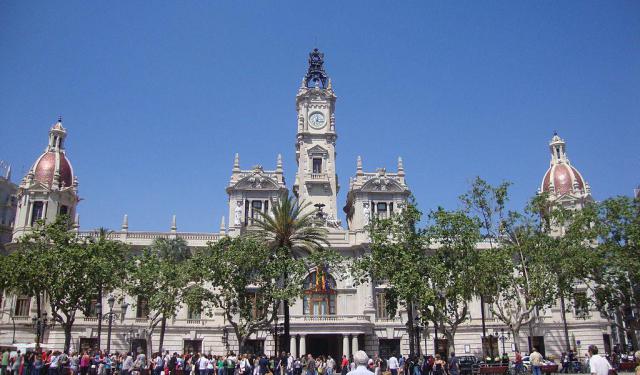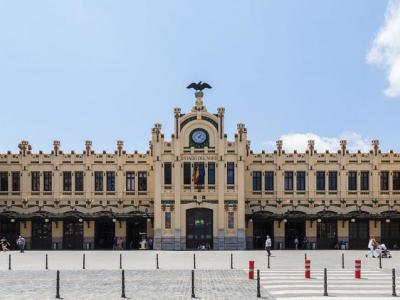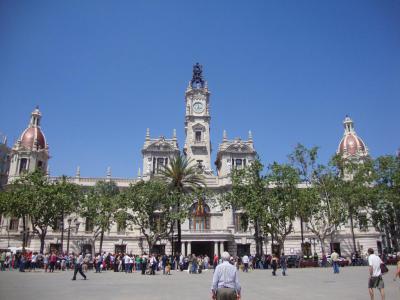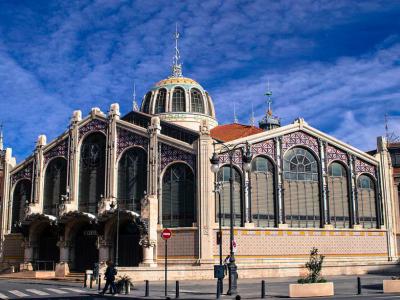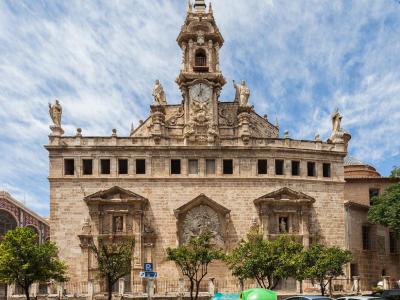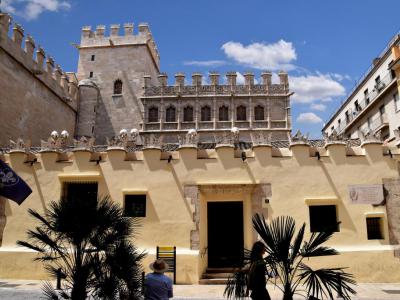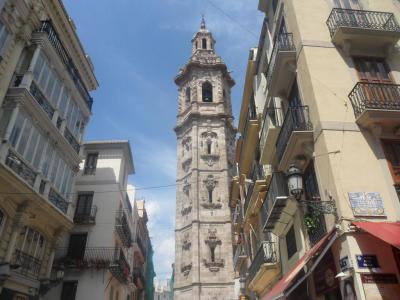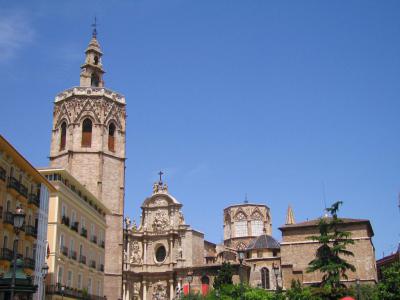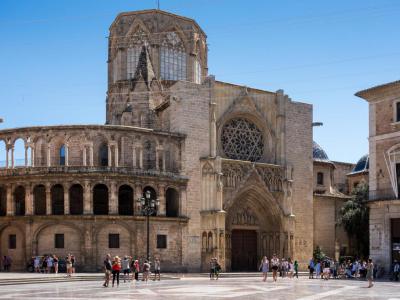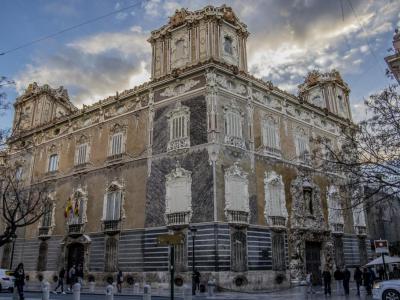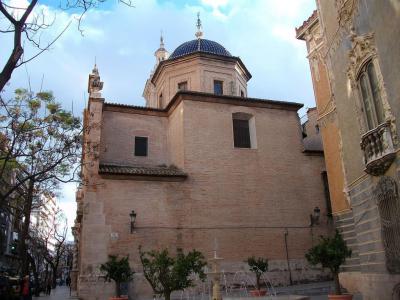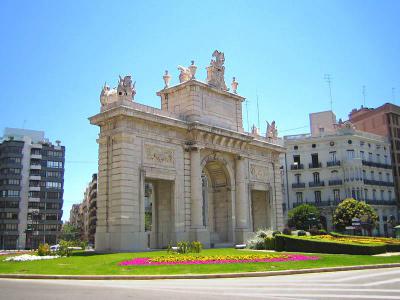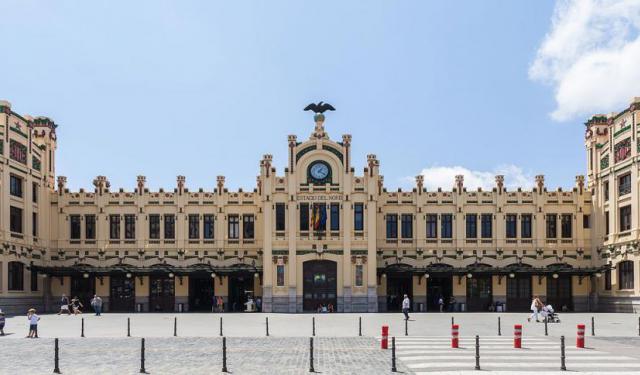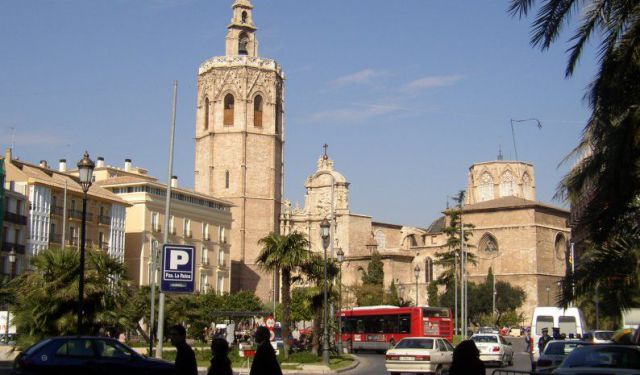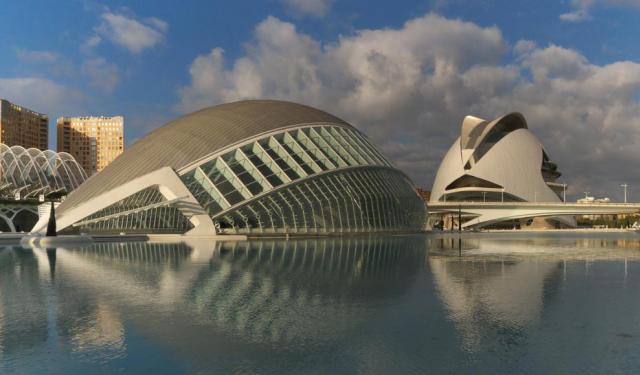Valencia's Classical Architecture Tour (Self Guided), Valencia
In Valencia, the architecture tells you right away-this city has layers. It's not just a coastal getaway with sunshine and beaches. Beneath the bright skies, “Spain’s Third Capital” reveals a blend of styles both rich and unexpected-at once bold in contrast and delicate in detail. Nowhere is this more evident than in the Old Town, where nearly every corner seems to offer a visual surprise.
The city’s new Christian era began in 1238, when King James I of Aragon reconquered Valencia. What followed was a sweeping transformation-mosques were repurposed into churches, and the Gothic style took hold in both sacred and civic architecture. Some of the most enduring landmarks from this period include the Silk Exchange, a powerful reminder of Valencia’s mercantile strength; the Church and Tower of Santa Catalina, where Gothic structure meets a dramatic bell tower; and the Miguelete Tower, rising beside the Cathedral, which itself blends Romanesque, Gothic, and Baroque styles, each one speaking to a different chapter in the city’s story.
From the 16th to the 18th century, Valencia saw another artistic shift. Churches like those of Saint John and Saint John of the Cross embraced full Baroque drama-ornate, expressive, and unapologetically grand. Civic architecture followed suit. The Town Hall, for example, mixes the symmetry of Neoclassicism with bursts of Baroque flourishes, giving the building a strong, ceremonial presence. Just around the corner, the National Museum of Ceramics occupies a Rococo palace that feels more like an elaborate stage set than a museum façade.
Then came the early 20th century, and with it, the rise of Valencian Modernisme. The North Railway Station stands out as a prime example: full of Art Nouveau curves and regional symbols, it’s both functional and exuberant. Just across the street, the Central Market takes that same spirit and fills it with motion-glass and iron structures wrapped around rows of produce.
Taken together, these buildings form a living timeline-an open-air archive of stonework, tile, and intricate craftsmanship. To discover them at your own pace, set out on a self-guided walking tour and see how Valencia’s architecture continues to tell its story, one façade at a time.
The city’s new Christian era began in 1238, when King James I of Aragon reconquered Valencia. What followed was a sweeping transformation-mosques were repurposed into churches, and the Gothic style took hold in both sacred and civic architecture. Some of the most enduring landmarks from this period include the Silk Exchange, a powerful reminder of Valencia’s mercantile strength; the Church and Tower of Santa Catalina, where Gothic structure meets a dramatic bell tower; and the Miguelete Tower, rising beside the Cathedral, which itself blends Romanesque, Gothic, and Baroque styles, each one speaking to a different chapter in the city’s story.
From the 16th to the 18th century, Valencia saw another artistic shift. Churches like those of Saint John and Saint John of the Cross embraced full Baroque drama-ornate, expressive, and unapologetically grand. Civic architecture followed suit. The Town Hall, for example, mixes the symmetry of Neoclassicism with bursts of Baroque flourishes, giving the building a strong, ceremonial presence. Just around the corner, the National Museum of Ceramics occupies a Rococo palace that feels more like an elaborate stage set than a museum façade.
Then came the early 20th century, and with it, the rise of Valencian Modernisme. The North Railway Station stands out as a prime example: full of Art Nouveau curves and regional symbols, it’s both functional and exuberant. Just across the street, the Central Market takes that same spirit and fills it with motion-glass and iron structures wrapped around rows of produce.
Taken together, these buildings form a living timeline-an open-air archive of stonework, tile, and intricate craftsmanship. To discover them at your own pace, set out on a self-guided walking tour and see how Valencia’s architecture continues to tell its story, one façade at a time.
How it works: Download the app "GPSmyCity: Walks in 1K+ Cities" from Apple App Store or Google Play Store to your mobile phone or tablet. The app turns your mobile device into a personal tour guide and its built-in GPS navigation functions guide you from one tour stop to next. The app works offline, so no data plan is needed when traveling abroad.
Valencia's Classical Architecture Tour Map
Guide Name: Valencia's Classical Architecture Tour
Guide Location: Spain » Valencia (See other walking tours in Valencia)
Guide Type: Self-guided Walking Tour (Sightseeing)
# of Attractions: 11
Tour Duration: 2 Hour(s)
Travel Distance: 3.3 Km or 2.1 Miles
Author: DanaOffice
Sight(s) Featured in This Guide:
Guide Location: Spain » Valencia (See other walking tours in Valencia)
Guide Type: Self-guided Walking Tour (Sightseeing)
# of Attractions: 11
Tour Duration: 2 Hour(s)
Travel Distance: 3.3 Km or 2.1 Miles
Author: DanaOffice
Sight(s) Featured in This Guide:
- Estacion del Norte (North Railway Station)
- Ayuntamiento (Town Hall)
- Mercado Central (Central Market)
- Iglesia de los Santos Juanes (Church of St. John)
- Lonja de la Seda (The Silk Exchange)
- Iglesia y Torre de Santa Catalina (Saint Catherine's Church and Tower)
- El Miguelete (Miguelete Tower)
- La Catedral (Valencia Cathedral)
- Museo Nacional de Ceramica (National Museum of Ceramics)
- Iglesia de San Juan de la Cruz (Church of St. John of the Cross)
- Porta de la Mar (Gate of the Sea)
1) Estacion del Norte (North Railway Station) (must see)
Valencia’s North Railway Station isn’t just a hub for travelers-it’s a destination in its own right. As the city’s main train terminal, it offers daily connections to Spanish cities like Barcelona and Madrid, as well as routes reaching the French border. But even if you’re not boarding a train, stepping inside is well worth your time.
Completed in the early 20th century, the building is a shining example of Modernista architecture-Spain’s answer to Art Nouveau. With its clean symmetry and regional flair, it blends function and elegance. The façade features vibrant mosaics and decorative elements that reflect the spirit and color of the Valencian region. Meanwhile, the interior is awash with natural light and playful design, from stained-glass windows to tiled murals.
Look for the original wooden ticket counters-now a rare sight-as well as ornamental light fixtures and stained-glass windows that filter soft, golden light across the floor. The entire first level is open to the public, while the mezzanine above is used for offices. For practical needs, you'll find a tourist information desk, a luggage storage facility, a small café-bar tucked away near platform 6, and a handful of shops for last-minute essentials or souvenirs.
It might seem a little unusual to include a railway station on your sightseeing list, but in Valencia, it makes perfect sense-especially with the historic bullring just next door. The two form a unique architectural pairing, contrasting early 20th-century elegance with neoclassical flair. And if you are catching a train, consider arriving early to give yourself time to wander and appreciate the artistic detail. The journey doesn’t always begin when the train departs-sometimes, it starts in the station.
Completed in the early 20th century, the building is a shining example of Modernista architecture-Spain’s answer to Art Nouveau. With its clean symmetry and regional flair, it blends function and elegance. The façade features vibrant mosaics and decorative elements that reflect the spirit and color of the Valencian region. Meanwhile, the interior is awash with natural light and playful design, from stained-glass windows to tiled murals.
Look for the original wooden ticket counters-now a rare sight-as well as ornamental light fixtures and stained-glass windows that filter soft, golden light across the floor. The entire first level is open to the public, while the mezzanine above is used for offices. For practical needs, you'll find a tourist information desk, a luggage storage facility, a small café-bar tucked away near platform 6, and a handful of shops for last-minute essentials or souvenirs.
It might seem a little unusual to include a railway station on your sightseeing list, but in Valencia, it makes perfect sense-especially with the historic bullring just next door. The two form a unique architectural pairing, contrasting early 20th-century elegance with neoclassical flair. And if you are catching a train, consider arriving early to give yourself time to wander and appreciate the artistic detail. The journey doesn’t always begin when the train departs-sometimes, it starts in the station.
2) Ayuntamiento (Town Hall)
Valencia’s elegant town hall anchors the square that shares its name, a landmark that reflects the city’s layered history. Construction began in 1758, but the building wasn’t fully completed until the early 20th century. As a result, it brings together a mix of architectural styles-primarily Neoclassical, but with clear touches of Neo-Baroque and Neo-Renaissance, making it a rich visual patchwork of different eras.
Step inside, and you’ll find more than just administrative offices. The building houses the Municipal History Museum, home to some of the city’s most treasured relics. Among the highlights are the sword said to have been wielded by King Jaime I during the conquest of Valencia, along with the very flag surrendered by the defeated Moors. There are also the ceremonial keys to the city, once held by its medieval rulers, and a beautifully detailed map of Valencia dating back to 1704-offering a fascinating glimpse into the city’s layout over 300 years ago.
Visitors are also welcome to explore the ornate function rooms, complete with sparkling chandeliers, grand staircases, and polished marble. And for those who want a different perspective, the balcony offers a sweeping view over the square below-a fantastic spot for people-watching or for catching one of the many parades or festivals that pass through the area.
Step inside, and you’ll find more than just administrative offices. The building houses the Municipal History Museum, home to some of the city’s most treasured relics. Among the highlights are the sword said to have been wielded by King Jaime I during the conquest of Valencia, along with the very flag surrendered by the defeated Moors. There are also the ceremonial keys to the city, once held by its medieval rulers, and a beautifully detailed map of Valencia dating back to 1704-offering a fascinating glimpse into the city’s layout over 300 years ago.
Visitors are also welcome to explore the ornate function rooms, complete with sparkling chandeliers, grand staircases, and polished marble. And for those who want a different perspective, the balcony offers a sweeping view over the square below-a fantastic spot for people-watching or for catching one of the many parades or festivals that pass through the area.
3) Mercado Central (Central Market) (must see)
Europe’s largest covered market-and arguably one of its most striking-Valencia’s Central Market is housed in a remarkable Modernista structure right in the heart of the Historic Center. While it may sit in a highly visited area, this market remains firmly rooted in everyday life, buzzing with locals who come here to stock up on hams, cheeses, vegetables, and fresh Mediterranean seafood. You’ll not only get a taste of authentic local life, but also the chance to discover regional specialties, and maybe even pick up a few souvenirs.
Though built for practical commerce, the building is anything but ordinary. Decorative flourishes in ceramic, brick, and stained glass come together in celebration of early 20th-century design. Look up, and you’ll even spot the red and yellow stripes of the Valencian flag worked into the architecture.
When it opened in 1928, the market hosted over 1,000 stalls. That number has since consolidated to around 700, still offering more than enough variety for a curious shopper or hungry traveler. For the full atmosphere, aim to visit around mid-morning, when the place comes alive with the rhythm of daily trade: voices calling out orders in Valencian, and baskets brimming with fresh produce. If you’re not heading out to the countryside to buy oranges, this is the place to grab some.
Many stalls sell herbs, spices, dried fruit, and nuts, while others surprise with items like ostrich meat or giant eggs. A separate section is devoted entirely to fish and seafood, and more adventurous food lovers might seek out snails, sweetbreads, or tripe.
Though built for practical commerce, the building is anything but ordinary. Decorative flourishes in ceramic, brick, and stained glass come together in celebration of early 20th-century design. Look up, and you’ll even spot the red and yellow stripes of the Valencian flag worked into the architecture.
When it opened in 1928, the market hosted over 1,000 stalls. That number has since consolidated to around 700, still offering more than enough variety for a curious shopper or hungry traveler. For the full atmosphere, aim to visit around mid-morning, when the place comes alive with the rhythm of daily trade: voices calling out orders in Valencian, and baskets brimming with fresh produce. If you’re not heading out to the countryside to buy oranges, this is the place to grab some.
Many stalls sell herbs, spices, dried fruit, and nuts, while others surprise with items like ostrich meat or giant eggs. A separate section is devoted entirely to fish and seafood, and more adventurous food lovers might seek out snails, sweetbreads, or tripe.
4) Iglesia de los Santos Juanes (Church of St. John)
Right in the thick of Valencia’s Market Square, wedged between the Central Market and the historic Silk Exchange, the Church of Saint John has long played a central role in the city’s religious and cultural life. Built in the 13th century on the site of an earlier mosque, the structure has seen multiple rebuilds over time. Fires and wear led to major renovations in the 14th and 16th centuries, which introduced Gothic features. A sweeping Baroque transformation came later, around the year 1700, giving it much of the theatrical flair we see today.
The façade draws the eye with its rich sculptural detail. At the center is a niche holding an image of the Virgin of the Rosary-shown with the Christ child resting one hand on a globe, surrounded by rays of light, angels, and cherubs. Higher up, a clock tower rises between two statues: one of Saint John the Baptist, identified by the lamb, and the other of John the Evangelist, symbolized by an eagle. At the top, a well-known weather vane known as the “Saint John’s Sparrow” adds a final touch.
Step inside, and the artistry continues. The ceiling is adorned with frescoes by Antonio Palomino, filled with imagery celebrating the Church Triumphant. Along the walls, thirteen plaster statues represent Jacob and the twelve tribes of Israel-each figure thoughtfully rendered and full of symbolism.
Officially declared a National Historic-Artistic Monument in 1947, the church has survived centuries of shifting tastes and city life. Thanks to ongoing restoration work, it's holding up beautifully-proof that with a little care, aging gracefully is entirely possible.
The façade draws the eye with its rich sculptural detail. At the center is a niche holding an image of the Virgin of the Rosary-shown with the Christ child resting one hand on a globe, surrounded by rays of light, angels, and cherubs. Higher up, a clock tower rises between two statues: one of Saint John the Baptist, identified by the lamb, and the other of John the Evangelist, symbolized by an eagle. At the top, a well-known weather vane known as the “Saint John’s Sparrow” adds a final touch.
Step inside, and the artistry continues. The ceiling is adorned with frescoes by Antonio Palomino, filled with imagery celebrating the Church Triumphant. Along the walls, thirteen plaster statues represent Jacob and the twelve tribes of Israel-each figure thoughtfully rendered and full of symbolism.
Officially declared a National Historic-Artistic Monument in 1947, the church has survived centuries of shifting tastes and city life. Thanks to ongoing restoration work, it's holding up beautifully-proof that with a little care, aging gracefully is entirely possible.
5) Lonja de la Seda (The Silk Exchange) (must see)
Just across from the Central Market is one of the city’s most beloved landmarks-a true cathedral of commerce. Known as the Silk Exchange, this grand structure was originally built for the silk trade and later used for broader commercial exchanges. A symbol of Valencia’s golden age in the late 15th century, it’s also one Europe’s finest examples of secular Gothic architecture.
The facade alone is a marvel of craftsmanship-elaborate stone carvings, delicate tracery, and distinctive windows line the walls. You’ll also notice a parade of gargoyles on the balustrades-28 in total, in the shape of winged creatures, beasts, and bats.
A central tower divides the structure into three main sections. Inside the tower, there’s a small chapel and a former debtor’s prison-used to hold merchants who failed to pay what they owed. To the left of the tower were two key institutions: one overseeing maritime trade, the other an early banking body that helped fund the construction. It’s well worth venturing inside to admire the ceilings-especially the Golden Hall upstairs, where a richly painted and gilded wooden ceiling dazzles with scenes of music, prophets, and mythological creatures.
But the soul of the building lies in the Transactions Hall, just to the right of the tower. Here, eight soaring spiral columns support a vaulted ceiling in a room divided into three aisles. Along the walls, a carved inscription proclaims: “I am a famous house which took fifteen years to build. See how fine a thing commerce can be when its words are not deceitful, when it keeps its oaths and does not practise usury. The merchant who lives in such a way will have riches and enjoy eternal life.”
When you’re done exploring, take a moment to relax under the orange trees in the peaceful courtyard-an ideal spot to catch your breath before moving on with your walking tour.
The facade alone is a marvel of craftsmanship-elaborate stone carvings, delicate tracery, and distinctive windows line the walls. You’ll also notice a parade of gargoyles on the balustrades-28 in total, in the shape of winged creatures, beasts, and bats.
A central tower divides the structure into three main sections. Inside the tower, there’s a small chapel and a former debtor’s prison-used to hold merchants who failed to pay what they owed. To the left of the tower were two key institutions: one overseeing maritime trade, the other an early banking body that helped fund the construction. It’s well worth venturing inside to admire the ceilings-especially the Golden Hall upstairs, where a richly painted and gilded wooden ceiling dazzles with scenes of music, prophets, and mythological creatures.
But the soul of the building lies in the Transactions Hall, just to the right of the tower. Here, eight soaring spiral columns support a vaulted ceiling in a room divided into three aisles. Along the walls, a carved inscription proclaims: “I am a famous house which took fifteen years to build. See how fine a thing commerce can be when its words are not deceitful, when it keeps its oaths and does not practise usury. The merchant who lives in such a way will have riches and enjoy eternal life.”
When you’re done exploring, take a moment to relax under the orange trees in the peaceful courtyard-an ideal spot to catch your breath before moving on with your walking tour.
6) Iglesia y Torre de Santa Catalina (Saint Catherine's Church and Tower)
The Church of Santa Catalina stands in one of the most architecturally striking areas of Valencia, right off La Paz Street and just a short walk from Queen’s Plaza. It’s among the city’s oldest places of worship, with roots going back to the 13th century. Built on the former site of a mosque after the Christian reconquest of 1238, the structure we see today is a testament to centuries of change.
What immediately catches the eye is the Baroque bell tower-added much later, in the 18th century-rising above the mainly Gothic body of the church. Its hexagonal shape and ornate style set it apart from the rest of the building, creating a dramatic contrast. Local lore says this tower is “married” to the Cathedral’s Miguelete tower, and at 56 meters high, it’s a familiar figure on the city’s skyline.
Over time, Santa Catalina has faced its share of hardships. A devastating fire in 1548 led to a Baroque-style reconstruction of much of the interior. Later, during the Spanish Civil War in 1936, the building was damaged once again. In the 1950s, a restoration campaign sought to peel back the layers of time and restore its original Gothic character.
One curious detail to look out for is a sculpted head of Saint Eligius, embedded in the wall near the entrance. As the patron saint of metalworkers and goldsmiths, his presence hints at the church’s past ties with the local silversmiths’ guild, who once maintained a chapel here. Beyond that, take your time to step inside, explore the side chapels, and admire the craftsmanship that has endured through the centuries.
What immediately catches the eye is the Baroque bell tower-added much later, in the 18th century-rising above the mainly Gothic body of the church. Its hexagonal shape and ornate style set it apart from the rest of the building, creating a dramatic contrast. Local lore says this tower is “married” to the Cathedral’s Miguelete tower, and at 56 meters high, it’s a familiar figure on the city’s skyline.
Over time, Santa Catalina has faced its share of hardships. A devastating fire in 1548 led to a Baroque-style reconstruction of much of the interior. Later, during the Spanish Civil War in 1936, the building was damaged once again. In the 1950s, a restoration campaign sought to peel back the layers of time and restore its original Gothic character.
One curious detail to look out for is a sculpted head of Saint Eligius, embedded in the wall near the entrance. As the patron saint of metalworkers and goldsmiths, his presence hints at the church’s past ties with the local silversmiths’ guild, who once maintained a chapel here. Beyond that, take your time to step inside, explore the side chapels, and admire the craftsmanship that has endured through the centuries.
7) El Miguelete (Miguelete Tower)
Rising next to the Cathedral in the heart of Valencia’s Old Town, this bell tower has been part of the city’s skyline-and identity-for more than 600 years. Construction started in 1381 and wrapped up in 1429, with several master builders leaving their mark along the way. Shaped like an octagonal prism, it’s a textbook example of Valencian Gothic style, reaching a total of 63 meters including the belfry. The structure’s height and perimeter are nearly identical, creating a sense of architectural symmetry that feels rather deliberate.
Although it began as a standalone tower, it was eventually incorporated into the Cathedral complex during a 15th-century expansion. Back in the day, its bells signaled when the city gates should open and close-functioning as both clock and public loudspeaker. The interior is divided into levels: the ground floor contains the staircase, the next level once served as a prison, followed by the bell-ringer’s living quarters, and finally the bell room itself at the top.
That upper chamber holds a collection of eleven bells, each with its own history and specific use. The star of the show is the massive Miguelete bell, cast in 1532 and weighing over 10 tons. It's so iconic, the entire tower took on its name. Some of the bells date back to the 14th century, and they’re still rung manually by the Cathedral’s dedicated bell ringers. With a bit of timing and luck, visitors can witness one of their traditional performances-known as “toques”-which are still executed exactly as they were centuries ago.
Access to the tower is through the Cathedral. Climbing the 207-step spiral staircase is no small feat, but reaching the terrace is well worth the effort. From the top, you’re treated to sweeping views of Valencia’s historic center, the Turia Gardens, and on a clear day, even a glimpse of the Mediterranean shimmering in the distance.
Although it began as a standalone tower, it was eventually incorporated into the Cathedral complex during a 15th-century expansion. Back in the day, its bells signaled when the city gates should open and close-functioning as both clock and public loudspeaker. The interior is divided into levels: the ground floor contains the staircase, the next level once served as a prison, followed by the bell-ringer’s living quarters, and finally the bell room itself at the top.
That upper chamber holds a collection of eleven bells, each with its own history and specific use. The star of the show is the massive Miguelete bell, cast in 1532 and weighing over 10 tons. It's so iconic, the entire tower took on its name. Some of the bells date back to the 14th century, and they’re still rung manually by the Cathedral’s dedicated bell ringers. With a bit of timing and luck, visitors can witness one of their traditional performances-known as “toques”-which are still executed exactly as they were centuries ago.
Access to the tower is through the Cathedral. Climbing the 207-step spiral staircase is no small feat, but reaching the terrace is well worth the effort. From the top, you’re treated to sweeping views of Valencia’s historic center, the Turia Gardens, and on a clear day, even a glimpse of the Mediterranean shimmering in the distance.
8) La Catedral (Valencia Cathedral) (must see)
As the centrepiece of Valencia’s old town, the Cathedral is quite modest on the outside, but full of surprises within. Built after the 13th-century Christian reconquest atop a mosque, it blends styles from several eras. The main body is Gothic, while the side chapels reflect an 18th-century renovation with neoclassical Corinthian columns. Brick walls and bare capitals give the nave an understated, austere quality. But at the center of the building, where the transept crosses the nave, things become more visually arresting. Instead of a traditional dome, an octagonal tower rises, pierced with alabaster windows and ringed by two tiers of pointed arches-remarkable works of 14th- and 15th-century stonecraft.
Above the high altar, recently uncovered Renaissance frescoes show musical angels in a deep-blue, star-filled sky. Elsewhere, the richly carved walnut choir stalls and the painted altarpiece display vivid biblical scenes. Don’t miss the alabaster statue of the Virgin known as “Our Lady of the Choir”. She is especially revered by expectant mothers, who circle the cathedral nine times in hopes of a safe and healthy delivery.
But the most famous artifact of all lies tucked away in a star-vaulted side chamber: what many believe to be the Holy Grail. Displayed behind an elaborate Gothic screen, the relic is a simple agate cup, dating to the 1st century BCE. It’s been fitted with medieval handles and has passed through royal and religious hands over the centuries.
The cathedral also houses a museum, where Roman foundations and medieval remains can be viewed in the basement. Upstairs, you’ll find an impressive collection of religious art-including pieces by Vicente Macip and his son, Juan de Juanes-showing just how dramatically artistic styles shifted from one generation to the next. Among the highlights are 14th-century carved apostles, early versions of the figures that now adorn the cathedral’s main entrance.
Above the high altar, recently uncovered Renaissance frescoes show musical angels in a deep-blue, star-filled sky. Elsewhere, the richly carved walnut choir stalls and the painted altarpiece display vivid biblical scenes. Don’t miss the alabaster statue of the Virgin known as “Our Lady of the Choir”. She is especially revered by expectant mothers, who circle the cathedral nine times in hopes of a safe and healthy delivery.
But the most famous artifact of all lies tucked away in a star-vaulted side chamber: what many believe to be the Holy Grail. Displayed behind an elaborate Gothic screen, the relic is a simple agate cup, dating to the 1st century BCE. It’s been fitted with medieval handles and has passed through royal and religious hands over the centuries.
The cathedral also houses a museum, where Roman foundations and medieval remains can be viewed in the basement. Upstairs, you’ll find an impressive collection of religious art-including pieces by Vicente Macip and his son, Juan de Juanes-showing just how dramatically artistic styles shifted from one generation to the next. Among the highlights are 14th-century carved apostles, early versions of the figures that now adorn the cathedral’s main entrance.
9) Museo Nacional de Ceramica (National Museum of Ceramics) (must see)
Housed in one of Valencia’s most extravagant landmarks, the National Museum of Ceramics finds its home in the Palace of the Marquis of Dos Aguas-an 18th-century Baroque marvel wrapped in layers of ornate fantasy. The entrance alone stops visitors in their tracks: carved from alabaster, it’s part religious homage, part architectural wordplay. Above the door, a depiction of the Virgin Mary gives way to symbolic imagery drawn from the marquis’ title, “Dos Aguas” or “Two Waters.” Flanking the doorway, semi-nude male figures recline as water pours from urns, representing the Turia and Júcar rivers, surrounded by swirling vines and lavish vegetation.
Step beyond that theatrical façade, and the interior more than lives up to expectations. Even if ceramics aren’t your passion, there’s plenty here to captivate. The palace rooms themselves are a sensory feast-columns twisted with golden grapevines, cherubs, and pink cornices set the tone. One of the highlights is the Carriage of the Nymphs, a real-life Cinderella coach, dripping in ornamental excess. The collection doesn’t stop there-it sprawls into canopied beds, antique furniture, rare bookplates, vintage posters, photographs, sketches, jewellery, and memorabilia tied to famed Valencians.
As for the ceramics themselves, the museum holds around 5,000 pieces. The timeline spans from prehistoric and Roman fragments to Eastern imports and striking works by Picasso. Among the finest are medieval pieces from nearby ceramic-making towns, known for their vivid greens, blues, and metallic glazes. Perhaps the most beloved exhibit is a fully reconstructed 19th-century Valencian kitchen, richly tiled and brimming with scenes of daily life-complete with images of food and animals.
Step beyond that theatrical façade, and the interior more than lives up to expectations. Even if ceramics aren’t your passion, there’s plenty here to captivate. The palace rooms themselves are a sensory feast-columns twisted with golden grapevines, cherubs, and pink cornices set the tone. One of the highlights is the Carriage of the Nymphs, a real-life Cinderella coach, dripping in ornamental excess. The collection doesn’t stop there-it sprawls into canopied beds, antique furniture, rare bookplates, vintage posters, photographs, sketches, jewellery, and memorabilia tied to famed Valencians.
As for the ceramics themselves, the museum holds around 5,000 pieces. The timeline spans from prehistoric and Roman fragments to Eastern imports and striking works by Picasso. Among the finest are medieval pieces from nearby ceramic-making towns, known for their vivid greens, blues, and metallic glazes. Perhaps the most beloved exhibit is a fully reconstructed 19th-century Valencian kitchen, richly tiled and brimming with scenes of daily life-complete with images of food and animals.
10) Iglesia de San Juan de la Cruz (Church of St. John of the Cross)
Dedicated to Saint John of the Cross, this church stands on ground that once held a mosque and was among the first in Valencia to be consecrated following the Christian Reconquest. The current building took shape in the early 1600s, a time of major stylistic change that gradually moved it toward the visual language of the Baroque and, later, the ornamental richness of the Rococo.
From the outside, the façade remains relatively understated-though not without detail. Solomonic columns and finely carved sculptures give it character, but the real spectacle unfolds inside. The interior is awash in Rococo stucco work from the late 18th century-an exuberant display of angels, flowing drapery, and swirling foliage that climbs the walls and wraps around the space, clearly drawing from Italian models but rendered with a distinctly local energy.
The church contains two side chapels, one of which was once maintained by Valencia’s Fisherman’s Guild. It's a small space, but rich in paintings and religious art-enough to captivate even those who aren’t usually drawn to churches or their architecture.
After sitting closed for over 50 years, the church reopened in 2009 following a major restoration project that brought the Rococo decoration back to life. The reopening coincided with “The Glory of the Baroque”, an exhibition that celebrated Baroque artistry across a number of historic churches in the city. Today, it's not just a place of worship, but a beautifully preserved piece of Valencia’s artistic heritage.
From the outside, the façade remains relatively understated-though not without detail. Solomonic columns and finely carved sculptures give it character, but the real spectacle unfolds inside. The interior is awash in Rococo stucco work from the late 18th century-an exuberant display of angels, flowing drapery, and swirling foliage that climbs the walls and wraps around the space, clearly drawing from Italian models but rendered with a distinctly local energy.
The church contains two side chapels, one of which was once maintained by Valencia’s Fisherman’s Guild. It's a small space, but rich in paintings and religious art-enough to captivate even those who aren’t usually drawn to churches or their architecture.
After sitting closed for over 50 years, the church reopened in 2009 following a major restoration project that brought the Rococo decoration back to life. The reopening coincided with “The Glory of the Baroque”, an exhibition that celebrated Baroque artistry across a number of historic churches in the city. Today, it's not just a place of worship, but a beautifully preserved piece of Valencia’s artistic heritage.
11) Porta de la Mar (Gate of the Sea)
Often seen as a symbolic link between Valencia’s historic centre and the sea, the original Gate of the Sea was built in 1356 as part of the city’s medieval walls, serving as the main access point to the port. Like much of the old fortifications, the gate was torn down in 1868 during a wave of urban development that reshaped the city’s layout. The structure standing there today was built in 1946-not as a defensive structure, but as a memorial to those who died during the Spanish Civil War.
Designed to echo the style of Roman triumphal arches, the monument features a central arch flanked by two rectangular passageways. Carved from white stone, its surface is rich with sculptural detail, including the heraldic bat above the main arch-an emblem long associated with the Kings of Aragon and with Valencia itself.
Beneath the arch, a large cross underscores the site’s solemn purpose, while the surrounding gardens offer a softer contrast to the stonework. These green spaces are occasionally redesigned, giving the setting a subtle sense of change while the monument itself remains a fixed reminder of the past.
Located at a busy crossroads, the gate is easy to reach by foot or public transport. Its position makes it an ideal jumping-off point for nearby sites like the Turia Gardens, the Glorieta Gardens, or a stroll back into the winding streets of the Old City.
Designed to echo the style of Roman triumphal arches, the monument features a central arch flanked by two rectangular passageways. Carved from white stone, its surface is rich with sculptural detail, including the heraldic bat above the main arch-an emblem long associated with the Kings of Aragon and with Valencia itself.
Beneath the arch, a large cross underscores the site’s solemn purpose, while the surrounding gardens offer a softer contrast to the stonework. These green spaces are occasionally redesigned, giving the setting a subtle sense of change while the monument itself remains a fixed reminder of the past.
Located at a busy crossroads, the gate is easy to reach by foot or public transport. Its position makes it an ideal jumping-off point for nearby sites like the Turia Gardens, the Glorieta Gardens, or a stroll back into the winding streets of the Old City.
Walking Tours in Valencia, Spain
Create Your Own Walk in Valencia
Creating your own self-guided walk in Valencia is easy and fun. Choose the city attractions that you want to see and a walk route map will be created just for you. You can even set your hotel as the start point of the walk.
Valencia Introduction Walking Tour
Valencia, Spain’s third-largest city, carries a rich history that stretches back to 138 BC, when it was founded as a Roman colony for battle-tested veterans. Known then as “Valentia”, meaning “valor,” it honored the courage of its first inhabitants. The city was destroyed in 75 BC by Pompey the Great but was rebuilt within a century, eventually becoming home to Visigoths and later the... view more
Tour Duration: 2 Hour(s)
Travel Distance: 3.2 Km or 2 Miles
Tour Duration: 2 Hour(s)
Travel Distance: 3.2 Km or 2 Miles
Old Town Walking Tour
Valencia’s Old Town stands apart from many in Europe for how effortlessly its many layers of history coexist. Beneath modern squares, ancient Roman streets and forum remains lie quietly preserved. The maze-like layout-shaped during the city’s Islamic period-was never swept away after the Christian Reconquest. Instead, it survived and evolved, now lined with Gothic churches and Baroque façades... view more
Tour Duration: 2 Hour(s)
Travel Distance: 3.0 Km or 1.9 Miles
Tour Duration: 2 Hour(s)
Travel Distance: 3.0 Km or 1.9 Miles
Contemporary Architecture Walk
With one foot in the past and the other one in the future, it is hard to find a European city more architecturally intriguing than Valencia. Among the multitude of styles, Valencia particularly excels at the cutting-edge contemporary architecture. She owes it to her own born and bred architect, Santiago Calatrava, renowned for his hyper-modern-surreal designs.
In the course of nearly two... view more
Tour Duration: 1 Hour(s)
Travel Distance: 1.4 Km or 0.9 Miles
In the course of nearly two... view more
Tour Duration: 1 Hour(s)
Travel Distance: 1.4 Km or 0.9 Miles
The Most Popular Cities
/ view all
